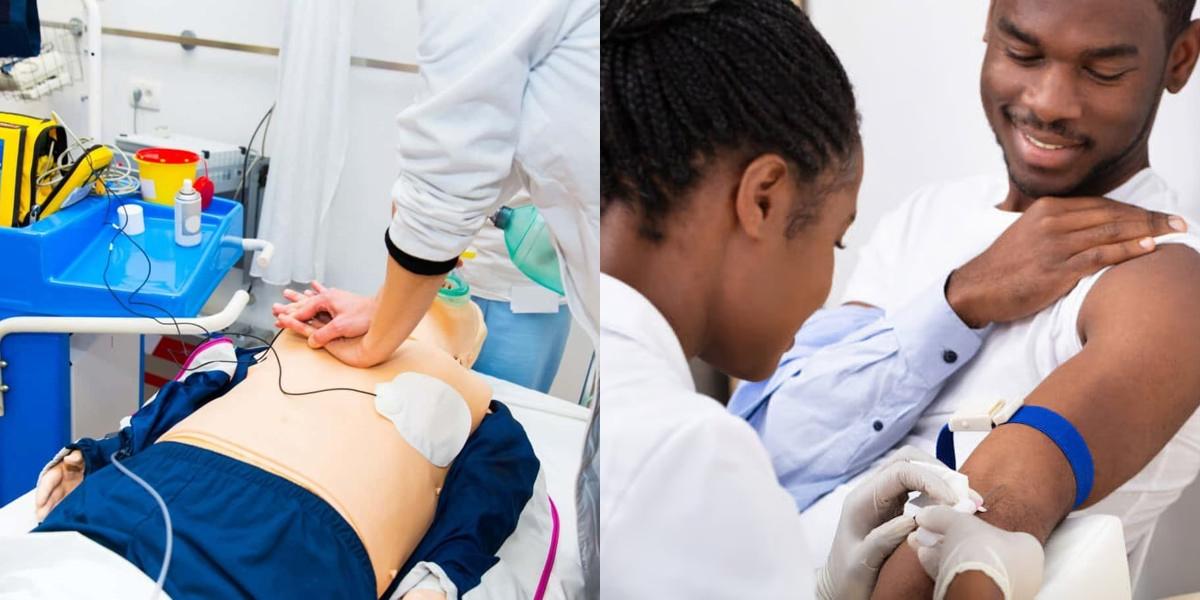ACLS vs Phlebotomy

Want personalized recommendations?
Let's match you to the right program

Key Points:
- ACLS (Advanced Cardiac Life Support) providers manage critical cardiac emergencies, while Phlebotomists collect blood samples for testing.
- ACLS professionals typically earn higher salaries than Phlebotomists due to their specialized skills and responsibilities.
- ACLS jobs are in high demand in hospitals and emergency settings, whereas Phlebotomist roles are available in various healthcare facilities.
- ACLS training is mostly in-person, while Phlebotomy training can be completed both online and in-person.
- ACLS training is generally more expensive and takes longer than Phlebotomy training.
ACLS and Phlebotomy are vital roles within the healthcare industry, yet they differ significantly in responsibilities, skill requirements, and career paths. Whether you’re interested in emergency care or diagnostic testing, understanding the differences between these two careers can help you make an informed decision about your future in healthcare.
Article continues after recommendations
Recommended for you
What Are ACLS and Phlebotomy?
ACLS (Advanced Cardiovascular Life Support):
ACLS involves a set of life-saving clinical interventions designed for healthcare professionals treating cardiac arrest, stroke, and other life-threatening emergencies. ACLS providers are trained to administer medications, manage advanced airways, and use life-saving equipment like defibrillators.
Phlebotomy:
Phlebotomy focuses on drawing blood for laboratory testing, research, or donation. Phlebotomists are responsible for identifying patients, preparing equipment, locating veins, and ensuring the proper handling of blood samples. They play a critical role in diagnostic healthcare, supporting accurate test results.
Key Differences Between ACLS and Phlebotomy
ACLS vs. Phlebotomy: Which Career Path is Best for You?
ACLS providers excel in emergency care, often earning higher salaries and working in high-stress environments like hospitals and emergency rooms. Phlebotomists, on the other hand, specialize in collecting blood, working in clinical settings with more predictable schedules. Choosing the right path depends on your interest in fast-paced medical interventions versus patient-focused diagnostics.
Job Descriptions
ACLS Job Description
ACLS-certified professionals work in emergency and critical care environments. Responsibilities include:
- Administering advanced life support, including CPR and defibrillation.
- Managing airways and performing intubation.
- Administering emergency medications.
- Using advanced medical equipment to monitor and stabilize patients.
- Collaborating with healthcare teams to deliver comprehensive care.
Phlebotomy Job Description
Phlebotomists focus on the safe and effective collection of blood samples. Responsibilities include:
- Identifying patients and verifying necessary information.
- Preparing equipment and ensuring safety during blood collection.
- Locating veins and performing venipuncture.
- Labeling, storing, and transporting blood samples for testing.
- Providing patient comfort and addressing concerns during procedures.
Education and Training
Get courses selected just for you
Try our powerful search engine
Article continues after recommendations
More recommendations for you
ACLS Education and Training
- Who Can Train: ACLS certification is primarily for licensed healthcare providers, such as nurses, paramedics, and doctors.
- Program Requirements: Courses offered by organizations like the American Heart Association (AHA) combine theoretical knowledge with hands-on training.
- Duration: Training typically takes a few days, but ongoing certification renewals and continuing education are required.
Phlebotomy Education and Training
- Who Can Train: Anyone with a high school diploma or GED can enroll in phlebotomy programs.
- Program Requirements: Programs are offered by vocational schools, community colleges, and hospitals, lasting a few months with classroom and clinical training.
- Certification: After completing a program, students can earn certification through organizations like the American Society for Clinical Pathology (ASCP).
Career Outlook and Salary
ACLS Career Outlook and Salary
- Demand: The demand for paramedics and EMTs (including ACLS providers) is projected to grow by 5% from 2022 to 2032, faster than the average for all occupations. This growth is driven by an aging population and the need for emergency medical services.
- Salary: As of 2023, the median annual wage for paramedics was $53,180, with the highest 10% earning over $79,430.
Phlebotomy Career Outlook and Salary
- Demand: The employment of phlebotomists is projected to grow by 10% from 2021 to 2031, which is faster than average. This growth reflects the increasing need for diagnostic testing in healthcare.
- Salary: As of 2023, the median annual wage for phlebotomists was $43,130, with the highest 10% earning over $54,000.
Final Thoughts
Choosing between ACLS and Phlebotomy depends on your career interests, skills, and long-term goals. If you’re drawn to fast-paced environments and critical patient care, ACLS may suit you best. However, if you prefer a structured role focused on diagnostics and patient interaction, phlebotomy could be a better fit. Consider job shadowing or volunteering to gain insights before committing to a career path.
Dreambound offers programs in both fields across various locations. Learn more here:

Marce Arnejo is part of the Sales team at Dreambound. Her role involves seeking out schools and institutions to provide valuable opportunities for students seeking a career in the healthcare sector. Beyond her professional life, Marce is passionate about music and gaming. She finds joy in exploring various genres of music and using gaming to unwind and immerse herself in virtual worlds. Her diverse interests enrich her personal life and contribute to her work by bringing new ideas and creativity.



